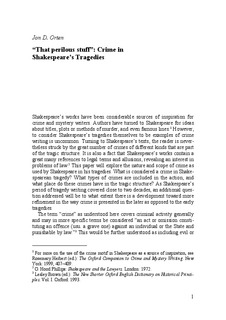| dc.description.abstract | Shakespeare's works have been considerable sources of inspiration for crime and mystery writers. However, to consider Shakespeare's tragedies themselves to be examples of crime writing is uncommon. This paper explores the nature and scope of crime as used in Shakespeare. The period focused on is between Shakespeare's first tragedy, Titus Andronicus (c. 1590), and his last, Coriolanus (c. 1608).
What is considered a crime in Shakespearean tragedy? What types of crimes are a part of the action, and what place do these crimes have in the tragic structure? There is not necessarily agreement as to what constitutes an instance of negligence or deviance that is deemed injurious to individuals or the state. However, the discussion includes references to overt criminal acts as well as to examples of criminal conduct not regarded as such by the individuals involved. A distinction could be made between offenses that are mala in se, i.e. "wrong in themselves" and mala prohibita, i.e. crimes that are differently judged from society to society or from time to time.
A further classification of crimes can be made depending on their seriousness and form of punishment. The types of crimes of primary interest in the tragic mode are grave offenses, i.e. felonies, rather than misdemeanours. The article will also consider to what extent there is a development in the way crime is presented from the early to the later tragedies | en |
